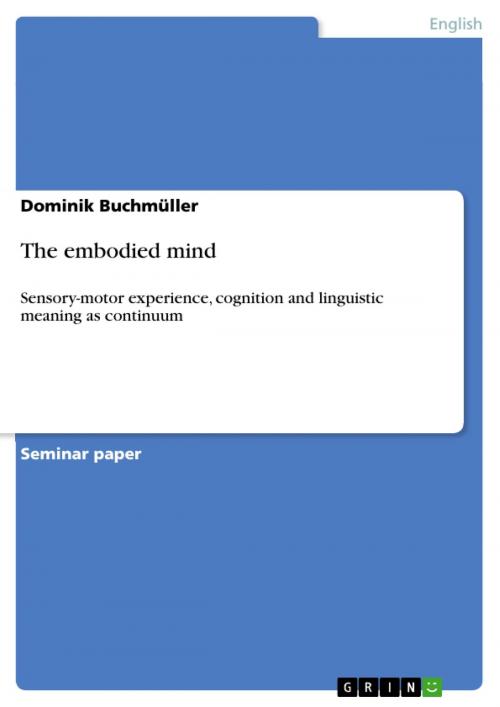The embodied mind
Sensory-motor experience, cognition and linguistic meaning as continuum
Nonfiction, Entertainment, Drama, Anthologies| Author: | Dominik Buchmüller | ISBN: | 9783638012225 |
| Publisher: | GRIN Publishing | Publication: | February 26, 2008 |
| Imprint: | GRIN Publishing | Language: | English |
| Author: | Dominik Buchmüller |
| ISBN: | 9783638012225 |
| Publisher: | GRIN Publishing |
| Publication: | February 26, 2008 |
| Imprint: | GRIN Publishing |
| Language: | English |
Seminar paper from the year 2007 in the subject American Studies - Linguistics, grade: 1,3, University of Bonn (Institut für Anglistik, Amerikanistik und Keltologie), course: Cognitive Linguistics, 20 entries in the bibliography, language: English, abstract: The 2.000 year old dichotomies of mind versus body and inner self versus external world are still ubiquitous in Western spontaneous philosophy (in Gramsci's sense), science and education. However, they cannot be empirically testified. On the contrary, more than thirty years of rich evidence from interdisciplinary cognitive science leave no doubt that the human mind is embodied in our entire organism and embedded in the world. The nature of our everyday sensory (i.e. visual, auditory, haptic, olfactory, gustatory, vestibular) and motoric experience, which is interactive and could be described as 'organism-environment co-ordination' (Johnson & Rohrer 10), constitutes our 'species-specific view of the world' (Evans & Green 45). Moreover it serves as information on the 'opportunities and costs of acting in the environment' (Proffitt 110) and thereby at least indirectly (i.e. via our individual conceptual structures derived from embodied experience of our natural and socio-cultural environment) guides our (linguistic) behaviour. Perception (i.e. processing of information obtained by our sensory system), cognition (i.e. conceptual representation of perceptual input and off-line employment of the concepts), consciousness (i.e. confluence of distinct phenom-ena such as first-person-perspective and volition) and action do not form clearly divided sys-tems of brain activity but function as continuum of ongoing interaction between our body, mind and ambiance. They are 'not merely contingently in individuals; they have also evolved together.' (Rosch & Thompson etc. 173) This paper will sum up the most fundamental findings from the branches of cognitive linguistics, psychology and neuroscience, giving account of the neural and mental structures and processes that link all (in equal measure physical) aspects of our existence. More precisely we are going to see how mechanisms of thought such as image schemas, conceptual domains and even metaphors are derived from bodily experience and how they are embodied themselves in the brain structure. Metaphor in particular will be looked at as a conceptual rather than purely linguistic device that structures our world view (including our political and scientific stance, cf. Lakoff Why the embodied... 33), language and social action in place of some universal, disem-bodied reason (which is a Rationalist illusion). Further we will be concerned with embodied language understanding on the basis of neural computation over so-called Perceptual Symbol Systems. Finally the reader will learn about the Neo-Whorfian notion of language as a 'shaper of thought' (Evans & Green 98) and why it does not contradict the Embodied Realist model of semantic structure encoding conceptual and ultimately perceptual structure.
Seminar paper from the year 2007 in the subject American Studies - Linguistics, grade: 1,3, University of Bonn (Institut für Anglistik, Amerikanistik und Keltologie), course: Cognitive Linguistics, 20 entries in the bibliography, language: English, abstract: The 2.000 year old dichotomies of mind versus body and inner self versus external world are still ubiquitous in Western spontaneous philosophy (in Gramsci's sense), science and education. However, they cannot be empirically testified. On the contrary, more than thirty years of rich evidence from interdisciplinary cognitive science leave no doubt that the human mind is embodied in our entire organism and embedded in the world. The nature of our everyday sensory (i.e. visual, auditory, haptic, olfactory, gustatory, vestibular) and motoric experience, which is interactive and could be described as 'organism-environment co-ordination' (Johnson & Rohrer 10), constitutes our 'species-specific view of the world' (Evans & Green 45). Moreover it serves as information on the 'opportunities and costs of acting in the environment' (Proffitt 110) and thereby at least indirectly (i.e. via our individual conceptual structures derived from embodied experience of our natural and socio-cultural environment) guides our (linguistic) behaviour. Perception (i.e. processing of information obtained by our sensory system), cognition (i.e. conceptual representation of perceptual input and off-line employment of the concepts), consciousness (i.e. confluence of distinct phenom-ena such as first-person-perspective and volition) and action do not form clearly divided sys-tems of brain activity but function as continuum of ongoing interaction between our body, mind and ambiance. They are 'not merely contingently in individuals; they have also evolved together.' (Rosch & Thompson etc. 173) This paper will sum up the most fundamental findings from the branches of cognitive linguistics, psychology and neuroscience, giving account of the neural and mental structures and processes that link all (in equal measure physical) aspects of our existence. More precisely we are going to see how mechanisms of thought such as image schemas, conceptual domains and even metaphors are derived from bodily experience and how they are embodied themselves in the brain structure. Metaphor in particular will be looked at as a conceptual rather than purely linguistic device that structures our world view (including our political and scientific stance, cf. Lakoff Why the embodied... 33), language and social action in place of some universal, disem-bodied reason (which is a Rationalist illusion). Further we will be concerned with embodied language understanding on the basis of neural computation over so-called Perceptual Symbol Systems. Finally the reader will learn about the Neo-Whorfian notion of language as a 'shaper of thought' (Evans & Green 98) and why it does not contradict the Embodied Realist model of semantic structure encoding conceptual and ultimately perceptual structure.















